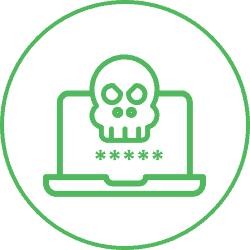Why is this happening?
Some key factors:
The rise of cybercrime-as-a-service has enlarged the pool of bad actors.
38% annual growth in cybercrime, driven mainly by CaaS2

These malicious actors have greater access to login credentials and often-reused passwords.
72% increase in data breaches from 2021 to 20233

Why are cybercriminals focusing on airlines?
| 1 | Airlines have historically prioritized allocating much of their budget to maintaining aircraft operations. | Only a small fraction – 7% of overall IT budget – is spent on cybersecurity, compared to airport investment of 10%.4 |
| 2 | There has been a massive increase in branded credit cards, which are tied to loyalty programs with enormous value. Airlines have a strong track record in preventing credit card fraud, so ATOs are an easier target. | US airlines alone now generate ancillary revenue of approximately $25B from co-branded credit cards,5 with hundreds of billions of dollars sitting in loyalty programs.6 |
How do the cybercriminals illicitly access these accounts?
Bad actors use bots to credential stuff their way into legitimate customer accounts.
166% rise in bot attacks on airlines7

The impact is enormous, with the total volume of payment fraud shifting from credit card fraud to ATOs.
$1B in losses per year to payment fraud for the airline industry10

Download the full infographic
Download PDF Version- Chris Staab in www.forbes.com/sites/jeremybogaisky/2024/06/28/airline-miles-hotel-points-hacking/
- www.securitymagazine.com/articles/98810-global-cyberattacks-increased-38-in-2022
- www.forbes.com/advisor/education/it-and-tech/cybersecurity-statistics/
- www.icao.int/NACC/Documents/Meetings/2018/CSEC/D12b-AirTransportCybersecurityInsights2018-SITA.pdf
- www.ideaworkscompany.com/wp-content/uploads/2024/04/Airline-Loyalty-and-Co-Branding.pdf
- www.thepaypers.com/expert-opinion/loyalty-fraud-in-the-airline-industry-key-insights-and-specificities--1267027
- Arkose Labs data, as found in www.forbes.com/sites/jeremybogaisky/2024/06/28/airline-miles-hotel-points-hacking/
- Chris Staab as quoted in www.forbes.com/sites/jeremybogaisky/2024/06/28/airline-miles-hotel-points-hacking/
- www.infosecurity-magazine.com/news/airlines-battle-loyalty-program/
- Chris Staab as quoted in www.forbes.com/sites/jeremybogaisky/2024/06/28/airline-miles-hotel-points-hacking/

